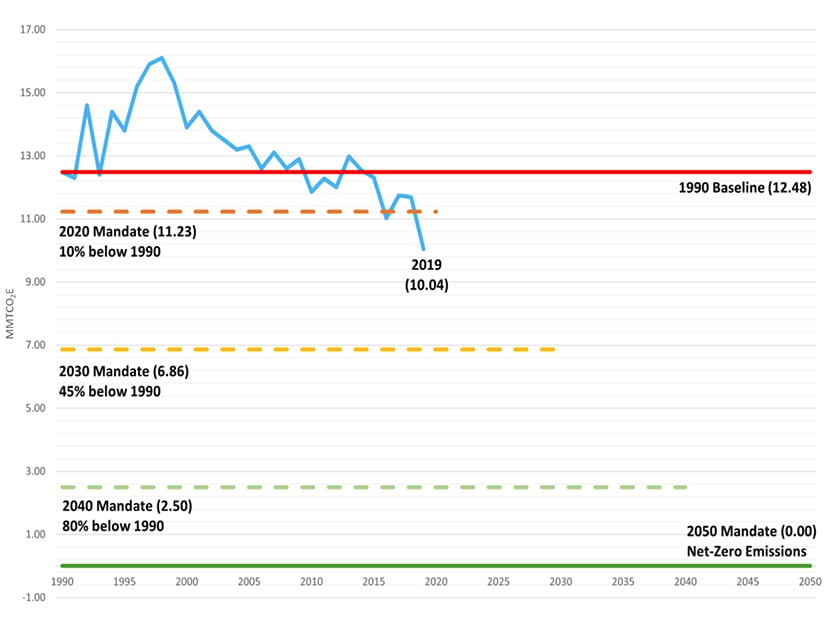Rhode Island Must Increase its Capacity to Make Climate Progress
Rhode Island has committed to combating climate change by adopting one of the strongest climate policies in the...
Under the Act on Climate, Rhode Island must meet 4 different emissions reduction mandates: 10% below 1990 levels by 2020; 45% by 2030; 80% by 2040; and net-zero emissions by 2050.
The Rhode Island Department of Environmental Management (RIDEM) recently released its 2020 greenhouse gas emissions inventory showing the state surpassed the first benchmark by reducing economy-wide emissions 20.1% below 1990 levels by 2020. While this may seem like the state is on track, we aren’t celebrating yet.
For starters, the 2020 benchmark of 10% below 1990 levels was incredibly low when you consider the ultimate goal is net zero by 2050. The state now faces a considerable challenge to reduce the remaining 90% of emissions by 2050. Massachusetts, for example, has an emissions reduction target of 25% below 1990 levels by 2020, putting the state on a better trajectory towards net zero by 2050.
Between 2019 and 2020, transportation emissions declined by 11.6% and residential heating emissions declined by 8.5%, but 2020 was an anomalous year. For transportation, the COVID-19 lockdown significantly reduced the number of cars on the road, resulting in drastic emissions reductions. For heating, 2020 was a significantly warmer year than 2019, resulting in less energy demand and therefore less emissions from heat.

The rate at which emissions decline must be far steeper than what we’re seeing. We essentially need what happened with transportation during the COVID-19 lockdown every year for the next 3 decades.
Another key aspect of Rhode Island’s greenhouse gas emissions inventory is how they account for the global warming potential (GWP) of methane emissions. GWP evaluates the climate impact that 1 ton of a certain greenhouse gas has compared to carbon dioxide. It considers both how much heat that greenhouse gas traps, as well as how long it stays in the atmosphere. Methane has a short lifespan of approximately 12 years in the atmosphere and is very efficient at trapping heat. To reconcile this lifespan difference, GWPs are expressed on either a 20-year or 100-year timescale. On a 100-year timescale, methane is 28x more powerful than CO2, whereas, on a 20-year timescale, it is 82x more powerful. Therefore, measuring methane over 20 years, rather than 100, is a more accurate reflection of its immediate impact, not to mention Rhode Island must be net-zero by 2050, not 2123. This approach would better emphasize the urgency of addressing methane emissions and align policy decisions with the short-term climate consequences. However, RIDEM is measuring methane on a 100-year timescale, significantly downplaying its impacts. We are advocating for them to switch their accounting methodology to 20 years, or at the very least publicly report the 20-year GWP even if the official emissions reduction targets are tied to the 100-year GWP.
As the Executive Climate Change Coordinating Council (EC4) works on its 2025 Climate Strategy, we urge them to put an emphasis on decarbonizing the thermal sector. Not only is this the sector that is most impacted by how the state measures methane emissions, but it is also the sector where the state is the most behind. The electric sector has the 100% renewable standard, and the transportation sector will have Advanced Clean Cars II and Advanced Clean Trucks, but the thermal sector has no major long-term policy to adequately address emissions in line with the Act on Climate. In addition to advocating for building decarbonization policies in the 2025 Climate Strategy, we plan to work on a legislative track. Stay tuned for blogs on our 2024 legislative agenda.
Rhode Island has committed to combating climate change by adopting one of the strongest climate policies in the...
UPDATE JUNE 6 2024: The Building Decarbonization Act urgently needs your help to pass in the House!
Call the...
Comments